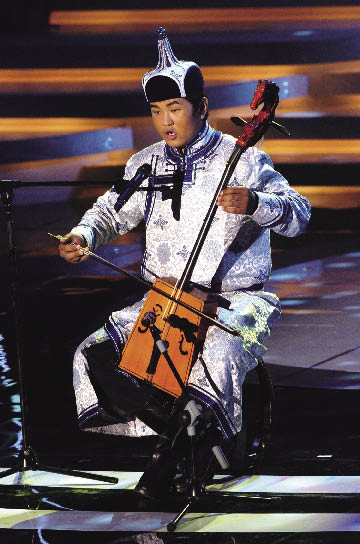|
Khoomei
 |
|
Throat-singer Haimu Ritai from Inner Mongolia performed in Hong Kong in 2006. Cnsphoto |
Khoomei, also known as Throat Singing, is the astonishing art of one singer taking two voice parts simultaneously. A throat singer produces the diversified harmonics of multiple voice parts with the overtone based on his/her continuous production of the bass part from the throat. This singing skill came into existence with the formation of the Mongolian people and has been passed down from generation to generation, master-to-apprentice, over past centuries. Their ancestors used to imitate the sound of animals, waterfalls and such when hunting and grazing on the Mongolian Plateau. They believed that imitating the sounds of nature was part of the harmonious and inseparable nature of humans and their environment. This is considered the root of Khoomei.
In China, this art finds its singers and audiences mainly in Xilin Gol in Inner Mongolia Autonomous Region and the Altai area in Xinjiang Uygur Autonomous Region.
As a form of laryngeal singing art, Khoomei requires special vocal treatment. Deep fundamental tones being carried by the vocal chords, while loud overtones are uttered from the cavity. Such fundamental separation of tones and overtones, together with breath control and changes in the syntonous point in the cavity, create rhythms in treble parts and form the peculiar impression of multiple voice parts. The distance between the undertone and high-tone may be as high as six octaves. Rhythms created in high-tones are sometimes similar to whistles or metallic sound. Such effects are praised as “high as reaching the top of welkin, low as touching the bottom of sea, and vast as the boundless land.”
Traditionally, Khoomei is performed only on very formal occasions so as to create an atmosphere of solemnity and respectfulness. Its basic theme focuses on the admiration and glorification of the universe, wild nature, ancestors and heroes. Similar to Urtiin Duu, Khoomei now is also performed during large gatherings other than rituals, such as banquets and horse races. But the timing and sequence of the songs are strictly regulated.
With generations of use and development, Khoomei has been the object of constant innovation. In the past, Khoomei could only be performed by male singers. However modern times see women learning this technique and giving performances on grand occasions too. Female vocals integrate exquisitely with male parts. Sometimes, men do the Khoomei bass roles while the women do the soaring aspects, forming a perfect choral effect. Today, Throat Singing can be performed solo or in chorus. Moreover, a chorus will sometimes combine the Khoomei skill with Urtiin Duu – one singing the tenor part in the Long Song style while others render the bass in throat singing.
Passing down the Magical Art
The Urtiin Duu and Khoomei have been listed by UNESCO as Masterpieces of the Oral and Intangible Heritage of Humanity. These arts are drawing increasingly more attention from the rest of the country and the world. Many more people are starting to learn the singing skills. Training classes for different forms are held to bring along talented youth making up the new generation of practitioners. The more they learn, the stronger their fascination with exploring Mongolian history and culture.
Currently, some universities and academic institutions in China have been engaged in the research and preservation of these two vocal miracles. Cultural exchanges between China, Mongolia and Russia have been held with Urtiin Duu and Khoomei as kind of emissaries of culture; all three countries have throat singing traditions, and this greatly increased mutual understanding and friendship between them.
Better protection and conservation is served through local festivals. Every year in Xilin Gol, a contest on Urtiin Duu is held, attracting competitors from the whole prefecture and other parts of the country. According to the organizers, the local officials for cultural affairs, such contests present an opportunity to record the songs and learn the history related to this art form.
Innovations on traditional songs are attracting an ever-increasing following among youth. Composed of young musicians from the Mongolian ethnic group, the band Hangai leads the way in reviving Mongolian folk art. They adapt the old songs from the grasslands, and use Khoomei skill along with traditional instruments to bring new life to the endangered music of their forefathers. The young singers say that every time they sing Mongolian folk songs, they feel calm and secure as if they have returned to the vast grasslands that underpin their culture. At the same time, aged folk singers are glad that the younger generation still love these enduring arts and devote themselves to passing it down.
The unique arts of Urtiin Duu and Khoomei reflect the philosophical attitude of the Mongols towards nature and life. Through the songs, we grasp the Mongolian spirit and its reception in the rest of the world. As ethereal monuments to this proud aesthetic tradition, Urtiin Duu and Khoomei are emblematic of northern nomadic culture. | 